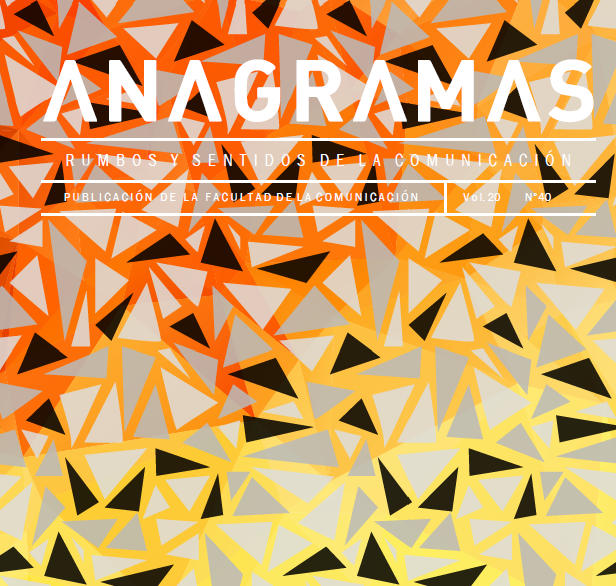The obituary: The inseparability of individual and social history in the genres of finitude
Main Article Content
Abstract
Obituary as a journalistic genre acquires special relevance within the current panorama of narratives that would help to weave the inseparability of individual and social history, in the foundation of the genres of life and in the treatment of the present, a statement that forces us to explore the origin of the representations that converge in the genres of life and infer that relationship in a particular way in the obituary. This article explores aspects of that individual and social order that circumscribes the consciousness of finitude, in the life and work of the sociologist Alfredo Molano (1944-2019), Commissioner of Truth for the clarification of the facts of war in Colombia and the construction of the truth (Truth Commission, 2020), who in life contributed to the construction of a culture of peace.
The genres of life have developed in various areas and the stories of death that appear in the obituary genre are not timeless and have their place in history. It is among the funereal origins as a 'certain look at life.' It reveals the little-known forms of an event and understood, many times, as a process, whose course and change also transforms the work and the individual.
The various journalistic representations analyzed from the realizations of the genre (typification, serial / individualized portraits, personalization of information, treatment of reality through its actors, descriptive effect, aspectualization, evocation, the appearance in an informative genre or of opinion, interpretation or narrative and section), are focused on finitude (obituaries, obituaries, tributes, biographies), and have been collected with the qualitative saturation technique.
Article Details
References
Abad, J. [JesusAbadColorado@AbadColorado]. (2019, 31 de octubre). Que tu camino esté lleno de luz [tuit]. Twitter. https://twitter.com/AbadColorado/status/1189860067807580167
Arbaïzar, Philippe. (1997). Portraits, singulier pluriel. Catalogue de l’exposition. Bibliothèque Nationale de France. http://editions.bnf.fr/portraits-singuliers-pluriels
Arcadia. (2019). Alfredo Molano Bravo (1944-2019), el hombre que supo escuchar. https://www.semana.com/libros/articulo/alfredo-molano-bravo-1944-2019-el-hombre-que-supo-escuchar/79758/
Barthes, R. (1957). Mythologies. Seuil.
Batard, A. (2010). Le portrait journalistique «: entre approfondissement et anecdote. En Le portrait : formes, catégories et fonction d’un genre. Actes du 132e Congrès national des sociétés historiques et scientifiques, «Images et imagerie » (pp. 39-49) Editions du CTHS
Bibliothèque Nationale de France (s.f.). Le site pedagogique. http://classes.bnf.fr/portrait/ateliers/chap2/index.htm
Baptiste, B. [Baptiste@Brigittelgb]. (2019, 31 de octubre). El silencio que deja Alfredo Molano será atronador: ¡¡¡la responsabilidad de su legado, su compromiso con la verdad y su amor por la gente y la tierra quedan en manos de todos... Gracias!!! [image attached] [tuit]. Twitter. https://twitter.com/Brigittelgb/status/1189868031968722944
Castañeda, P. (2019, 31 de octubre). Un asesinato duele. Pero los desaparecidos son puntos suspensivos de dolor: Alfredo Molano. Revista Semana. https://semanarural.com/web/articulo/alfredo-molano-y-la-busqueda-de-la-verdad-en-el-sur-de-colombia/832
Chantraine, O. (1985). Ophélie, didactique des techniques d’expression et portraits institutionnels. Études de communication, (6), A27-A55. https://doi.org/10.4000/edc.3148
Comisión de la Verdad. (2020). Alfredo Molano Bravo. https://comisiondelaverdad.co/actualidad/blogs/alfredo-molano-bravo
Córdova, J. (2015). Estrategias metodológicas en investigación. En Pautas metodológicas para investigar en Ciencias Sociales y Humanas (pp. 103- 161). Universidad de Posgrado para la Investigación Estratégica en Bolivia.
Cotentin, G. (2019). Parcours litteraires. http://cotentinghislaine.wixsite.com/parcours-litteraires/autres-genres
El Espectador. (2019, 31 de octubre). Murió Alfredo Molano Bravo, comisionado de la verdad y periodista.
González, J. (2004). Periodismo biográfico. En Repensar el periodismo: transformaciones y emergencias del periodismo actual (pp. 123 - 140) Universidad Del Valle.
Gratton, A. y Trekker A. (2016). Penser l’accompagnement biographique. Academia-L’Harmattan.
Gutiérrez, A. (2019). Metáfora y construcción social Universidad Nacional Autónoma de México. Athenea Digital, 19(1). https://doi.org/10.5565/rev/athenea.2049
Hernández. R. (2019, 30 de diciembre). In memoriam: colombianos que nos dejaron en el 2019. Radio Nacional de Colombia. https://www.radionacional.co/noticia/actualidad/memoriam-colombianosque-nos-dejaron-2019
Hudec, V. (1984). El periodismo: Esencia, Funciones Sociales, Desarrollo. Santiago de Cuba.
Kalina, V. y Dolanska, N. (1984). Zanry umelecké publicistiky. Knihovnická Novinare.
Laborde, I. (1998). Le portrait de presse: ¿un genre descriptif? Pratiques: Linguistique, litterature, didactique, (99), 70-88. https://www.persee.fr/doc/prati_0338-2389_1998_num_99_1_1821
Lee Anderson, J. (2005). El arte de dibujar con palabras a una persona. Taller de perfiles. Fundación de Nuevo Periodismo Iberoamericano. https://fundaciongabo.org/es/recursos/relatorias/el-artede-dibujar-con-las-palabras-una-persona-taller-de-perfiles-con-jon-lee
Ling K., Taylor, C. y Anna Marchi (eds.). Corpus Approaches to Discourse. A Critical Review. Applied Linguistics, 42(1), 198-202, https://doi.org/10.1093/applin /amy058https://academic.oup.com/applij/article-abstract/42/1/198/5237767?redirectedFrom=fulltext
López, A. (1999). La necrológica como género periodístico. Revista Latina de Comunicación Social, (15), 172-183.
Maddrell, A. (2016) Mapeo del duelo. Un marco conceptual para comprender las dimensiones espaciales del duelo, el luto y el recuerdo. Social y Cultural Geography, 17(2), 166-188.
Mantilla, I. [@MantillaIgnacio]. (2019, 31 de octubre). Se nos va hoy un valioso colombiano [tuit]. Twitter. https://twitter.com/MantillaIgnacio/status/1189861839015960578
Maulpoix, J.M. (2018). Une histoire de L’élégie. Pocket. Molano, A. [@AlfredoMolanoJi]. (2019, 31 de octubre). A quienes quisieron a mi padre, Alfredo Molano Bravo, les cuento mi dolor por su partida. Hasta el último día de su vida peleó con todas sus fuerzas [tuit]. Twitter. https://twitter.com/alfredomolanoji/status/1189859620392783872
Nieto-Flores, M., Berrios, P. Extremera, N. (2015). Recursos personales asociados a diferentes indicadores de éxito en la búsqueda activa de empleo: una revisión sistemática. Behavioral Psychology. Revista Internacional de Psicología Clinica y de la Salud, 23(2). https://www.behavioralpsycho.com/producto/recursos-personales-asociados-a-diferentes-indicadoresde-exito-en-la-busqueda-activa-de-empleo-una-revision-sistematica/
Ponsford, M. (2013, 13 de junio). Una soledad desobediente. Revista Arcadia. https://www.revistaarcadia.com/impresa/portada/articulo/alfredo-molano-bravo-una-soledaddesobediente/
/
Ponsford, M. (2019, 31 de octubre). Una soledad desobediente. Revista Semana. https://www.semana.com/impresa/portada/articulo/alfredo-molano-bravo-una-soledad-desobediente/32148/
Real Academia Española. (1734). Diccionario de Autoridades. Grupo 3 Academia. https://apps.rae.
es/ntlle/
Revista Semana. (2019, 21 de diciembre). Los colombianos que nos dejaron en 2019. https://www.semana.com/cultura/articulo/que-famosos-murieron-este-ano/646006
Rivano, E. (1999). Metáfora y Lingüística Cognitiva. Bravo y Allende Editores.
Rosero, M. (2919, 19 de diciembre). El campesinado fue su bandera. Arcadia. https://www.semana.com/agenda/articulo/el-campesinado-fue-su-bandera-una-lider-social-habla-de-alfredomolano/79839/
Semana. (2019, 31 de octubre). El país lamenta la muerte de Alfredo Molano, uno de los periodistas
más importantes de los últimos tiempos. Revista Semana. https://www.semana.com/nacion/articulo/fallecio-alfredo-molano/638459
Shnedecker, C. (2005). Les chaînes de référence dans les portraits journalistiques: éléments de description. Travaux de linguistique, (51), 85-133. https://www.cairn.info/revue-travaux-delinguistique-2005-2-page-85.htm
Souriau, E. (1990). Vocabulaire d’esthétique. Bibliothèque Nationale de France. http://classes.bnf.fr/portrait/artportr/index.htm
Trueblood, A. S. (1992) La Dorotea y la Elegía di Madonna Fiammetta. Bulletin of Hispanic Studies, (69), 83-89.
Universidad de Almería. (s.f.). Características de la elegía. https://w3.ual.es/personal/fjgarcia/Lit_2_2.htm





